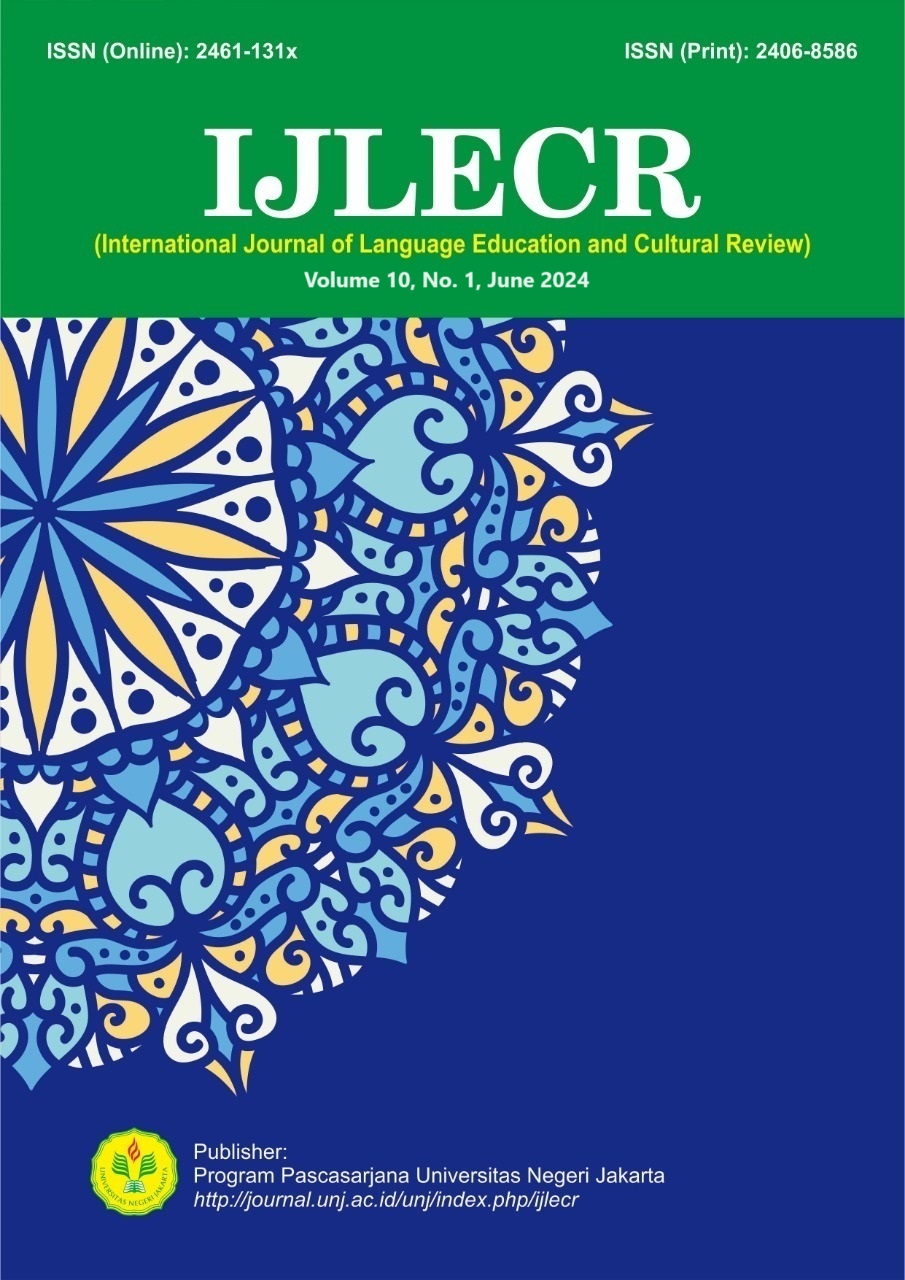Analysis of the Experience of Losing a Female Character in the Short Story Maukah Kau Menghapus Bekas Bibirnya di Bibirku dengan Bibirmu? by Hamsad Rangkuti
DOI:
https://doi.org/10.21009/ijlecr.v10i1.44488Keywords:
Loss Heor, Short Story, Psychological Phases, Elisabeth Kübler-RossAbstract
Literary works are a reflection of real life experienced by humans. Every human being must experience loss. Not only in real life, events of loss can also be found in literary works through the characters or stories contained in them. Humans will experience phases when experiencing loss. These phases will be analyzed in this research through literary works in the form of short stories. The aim of this research is to analyze the experience of loss in the characters in the short story "Maukah Kau Menghapus Bekas Bibirnya di Bibirku dengan Bibirmu?" by Hamsad Rangkuti's using Elisabeth Kübler-Ross's theory of loss. This research uses a literature study approach by collecting psychological theory references to dissect literary works. Research results from the analysis of the short story "Maukah Kau Menghapus Bekas Bibirnya di Bibirku dengan Bibirmu?" by Hamsad Rangkuti's found that the female character in the short story experienced five phases in the event of loss, namely 1) denial phase, 2) anger phase, 3) offering phase, 4) depression phase, and 5) acceptance phase. It turns out that Elisabeth Kübler-Ross's theory of loss does not only occur in everyday life, but in a literary work in the form of a short story, this theory of loss can also be experienced by the character. A short story written by Hamsad Rangkuti with the title "Maukah Kau Menghapus Bekas Bibirnya di Bibirku dengan Bibirmu?" proves that Elizabeth Kübler-Ross's theory corresponds to the phases of loss felt by humans.
References
Ahmad, E. H. (2019). Cognitive-behavioral therapy untuk menangani kemarahan pelaku bullying di sekolah. JBKI (Jurnal Bimbingan Konseling Indonesia), 4(1), 14-18.
Aritonang, D. E. (2023). Peran PAK dalam proses penyembuhan mental remaja yang berduka berdasarkan teori 5 stages of grief. Apostolos: Journal of Theology and Christian Education, 3(2), 109-1117. https://doi.org/10.52960/a.v3i2.226.
Berliana, D., Ken W., & Marta W. (2020). Bentuk kehilangan dan tahap berdukadalam novel Lost karya Rizal Afif dan Nia Janiar. Sabda: Jurnal Kajian Kebudayaan, 15(2). https://doi.org/10.14710/sabda.15.2.%p.
Depdiknas. (2003). Undang-Undang RI No.20 Tahun 2003 tentang Sistem Pendidikan Nasional. (Law Number 20 of 2003 concerning the National Education System).
Gani, M. L. A. (2022). Penerimaan diri pada tokoh utama film “Sound of Metal”. DESKOVI: Art and Design Journal, 5(1), 1—4. http://dx.doi.org/10.51804/deskovi.v5i1.1527.
Hayati, R., & Indra, S. (2018). Gambaran tingkat marah dan perilaku agresif pada remaja. Prosiding Seminar Nasional Hasil Penelitian, 1(1). 395-398.
Kartolo, R. (2014). Kajian tokoh Arimbi dalam novel “Detik Terakhir” karya Alberthine Endah dari sudut psikologis. Visipena Journal, 5(2), 77–84. https://doi.org/10.46244/visipena.v5i2.271.
Kübler Ross, E. (1998). On death and dying. Jakarta: PT. Gramedia Pustaka Utama.
Kurniawan, E. D. (2017). Nekrobiopsi: bedah cerita pendek dengan teori psikologi Yogyakarta: CV Komojoyo Press.
Minderop, A. (2010). Psikologi sastra: karya sastra, metode, teori, dan contoh kasus. Jakarta: Pustaka Obor Indonesia.
Pane, A. A., & Olga N. K. (2024). Penerapan terapi kreatif dan arsitektur terapeutik dalam menciptakan “tempat ketiga” bagi remaja untuk memproses duka. Jurnal Sains, Teknologi, Urban, Perancangan, Arsitektur (Stupa), 6(1), 273-284. https://doi.org/10.24912/stupa.v6i1.27472.
Rangkuti, H. (2016). Maukah kau menghapus bekas bibirnya di bibirku dengan bibirmu?. Yogyakarta: Diva Press.
Ratna, N. K. (2004). Teori, metode, dan teknik penelitian sastra. Yogyakarta: Pustaka Belajar.
Riyadi, A. L. Dkk. (2022). Representasi rasa kehilangan pada iklan XL Axiata versi “pesan untuk Raka” di Youtube (analisis semiotika Roland Barthes pada iklan Youtube). Jurnal Komunikatio, 8(1), 1—18. https://doi.org/10.30997/jk.v8i1.4774.
Saefudin, D. P., Mulyadi, & Prima P. P. S. (2023). The analysis of flouting maxim in the @pepekomik comic strip. SALEE: Study of Applied Linguistics and English Education, 4(2), 367-379. https://doi.org/10.35961/salee.v4i2.764.
Semi, M. A. (1993). Metode penelitian sastra. Bandung: PT. Angkasa.
Seputro, A. A. (2022). Teknik grief counseling dalam mengatasi kedukaan pada remaja yang kehilangan orang tua. Jurnal Pendidikan dan Pembelajaran, 2(3), 73-78.
Setiawan, A. A. (2009). Ya Tuhan, mengapa kau ambil dia dariku? Penghiburan bagi orang berduka. Jakarta: PT. Gramedia Pustaka Utama.
Shear, M. K. (2012). Grief and mourning gone awry: Pathway and course of complicated grief. Dialogues in Clinical Neuroscience, 14(2), 119-128. https://doi.org/10.31887/DCNS.2012.14.2/mshear.
Siswantoro. (2010). Metode penelitian sastra. Yogyakarta: Pustaka Pelajar.
Sugara, H., & Hanifa, M. (2024). Analisis hierarki kebutuhan Abraham Maslow dalam cerpen “Pelajaran Mengarang” karya Seno Gumira Ajidarma. Literasi: Jurnal Bahasa dan Sastra Indonesia serta Pembelajarannya, 8(1), 35-40. http://dx.doi.org/10.25157/literasi.v8i1.13628.
Surakhmad, W. (1994). Pengantar penelitian ilmiah. Bandung: Tarsito.
Utami, N. P. (2023). A.DAP.TA.SI. Jakarta: PT. Elex Media Komputindo.
Wicaksono, A. (2014). Pengkajian prosa fiksi. Jakarta: Garuda Waca.
Widiastuti, R., Ratih R., Emma M., & Sueb. (2023). Depresi dan solusi tokoh Anna dalam novel Represi karya Fakhrisina Amalia. Sawerigading, 29(2). 273-286. https://doi.org/10.26499/sawer.v29i2.994.
Wellek, R. & Austin W. (2016). Teori kesusatraan. Jakarta: PT. Gramedia Pustaka Utama.
Yuanti, A. H., Putri, D. P. S., & Kurniawan, E. D. (2023). Analisis emosi kesedihan tokoh Jim dalam novel Harga Sebuah Percaya karya Tere Liye: kajian teori Kübler-Ross. Gudang Jurnal Multidisiplin Ilmu, 1(6), 118-122. https://doi.org/10.59435/gjmi.v1i6.163.








